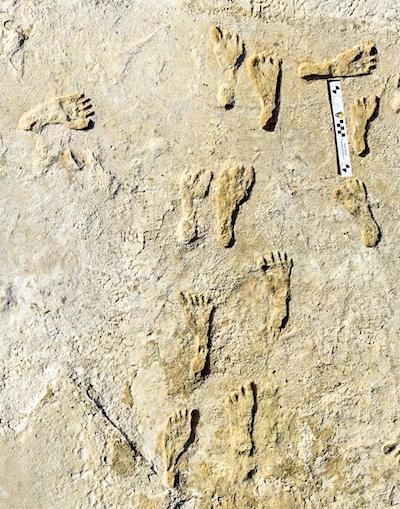
Painting of study site during the Last Glacial Maximum depicting human and megafaunal co-existence through time./NPS, Karen Carr
Additional tests have confirmed that fossilzed footprints found in today's White Sands National Park in New Mexico date back as much as 23,000 years ago.
Two years ago scientists announced in the journal Science that the tracks were laid down between 21,000 and 23,000 years ago. At the time, the landscape contained a prehistoric lake, Palaeo-lake Otero, that ebbed in size with groundwater supplies and precipitation, according to the scientists. Most of the tracks were laid down on the eastern shores of this lake, they noted.
The trackways were initially found about a dozen years ago by David Bustos, the national park's chief of resources. The tracks showed that someone followed a sloth, purposely stepping in its tracks as they did so, he said back in 2018. Team member Matthew Bennett, a professor of environmental and geographical sciences at Bournemouth University in England, at the time said the ancient humans appeared to be stalking the sloth.

White Sands has the largest collection of fossilized human footprints/NPS
But questions arose over the dating procedures used to conclude the footprints were between 20,000 and 23,000 years old. Specifically, some argued that the ancient seeds from the aquatic plant (Ruppia cirrhosa) that were used to date the surfaces the footprints were embedded in "have the potential to be affected by old carbon reservoir effects that could influence the reported radiocarbon ages and make them appear older than they truly are."
In response, Jeffery Pigati and Kathleen Springer, two U.S. Geological Survey scientists, and their colleagues came up with additional evidence to confirm the initial dating.
“We always knew that we would have to independently evaluate the accuracy of our ages to convince the archaeological community that the peopling of the Americas occurred far earlier than traditionally thought,” said Pigati in a release.
In their new work, the researchers presented "calibrated carbon-14 ages of terrestrial pollen collected from the same stratigraphic contexts as the Ruppia seeds. Unlike the seeds, conifer pollen fixes atmospheric carbon and, therefore is not subject to potential old carbon reservoir effects."
The results from the new testing resulting calibrated carbon-14 ages range from 23.4 ± 2.5 – 22.6 ± 2.3 thousand years ago.
“Even as the original work was being published, we were forging ahead to test our results with multiple lines of evidence and independent chronologic techniques,” said Springer, co-lead author of the study. “Although we were confident in the original seed ages, we wanted to develop community confidence in them as well. Our new ages, combined with the strong geologic, hydrologic, and stratigraphic evidence, unequivocally support the conclusion that humans were present in North America during the Last Glacial Maximum.”
It long has been generally accepted by the scientific community that humans were able to cross the Bering Land Bridge from Asia into North America between 13,000 and 14,000 years ago. This research pushes that date back by roughly 10,000 years.


 Support Essential Coverage of Essential Places
Support Essential Coverage of Essential Places







Comments
Isn't it possible that the tracks were made by individuals who had migrated north toward the glacial ice pack from their arrival point to the south? Could these have been made by humans who descended from those who crossed the Pacific Ocean, west to east, rather than from those who crossed into North America from Siberia?